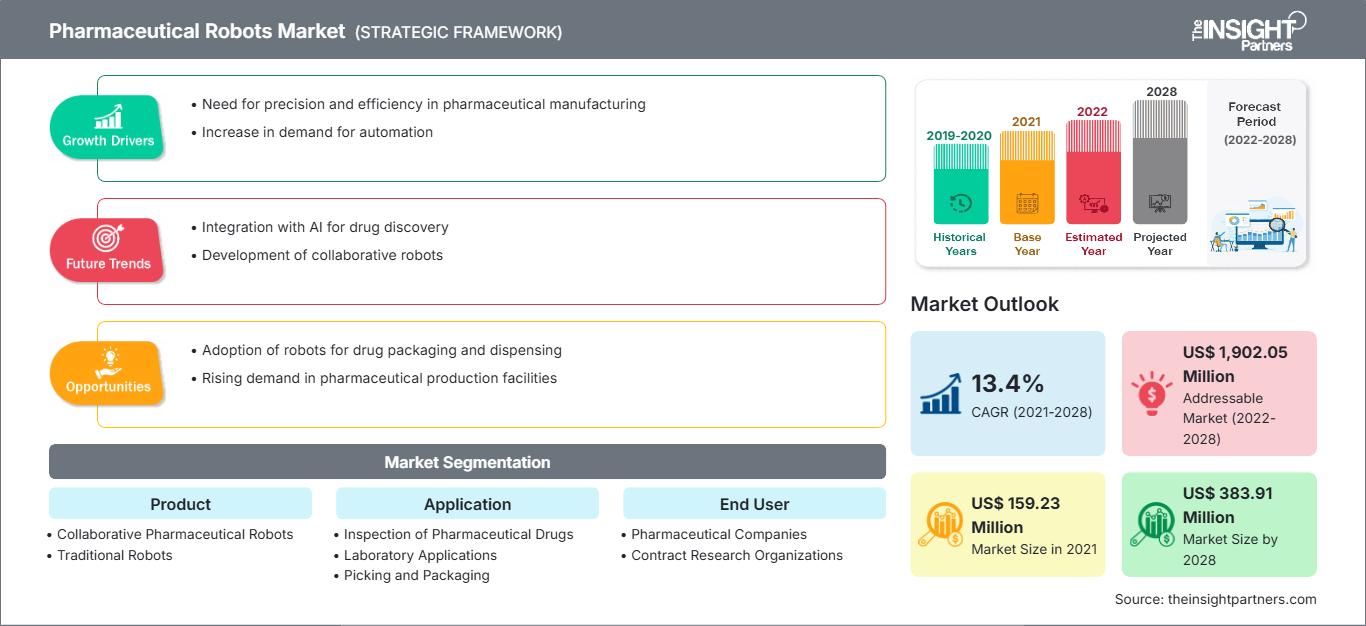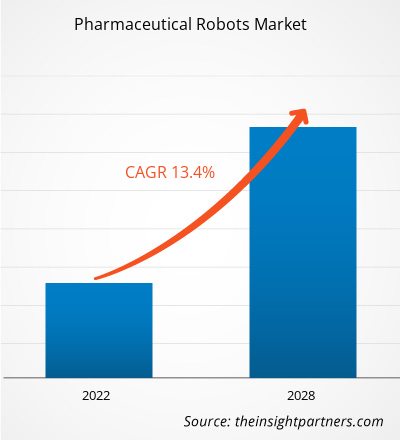[Informe de investigación] Se prevé que el mercado de robots farmacéuticos alcance los 383,91 millones de dólares estadounidenses en 2028, frente a los 159,23 millones de dólares estadounidenses en 2021; se espera que crezca a una tasa de crecimiento anual compuesta (TCAC) del 13,4 % entre 2021 y 2028.
La industria farmacéutica exige una producción eficiente y precisa de medicamentos. Por ello, el uso de robots en la fabricación farmacéutica mejora la calidad y reduce costes y tiempos. Los robots están demostrando ser ventajosos en el llenado, la inspección, el envasado, los laboratorios y la fabricación de medicamentos personalizados. Un sistema robótico es un tipo de automatización con múltiples ejes de movimiento que puede programarse para realizar cualquier función.
El informe ofrece información y un análisis exhaustivo del mercado de robots farmacéuticos, haciendo hincapié en diversos parámetros como las tendencias del mercado, los avances tecnológicos, la dinámica del mercado y el análisis del panorama competitivo de los principales actores del mercado a nivel mundial. También incluye el impacto de la pandemia de COVID-19 en el mercado en todas las regiones. El impacto de la pandemia y la disminución de las actividades de investigación globales han perjudicado las operaciones y el desempeño financiero de varias empresas en el mercado de robots farmacéuticos. La OIE, la Organización Mundial de Sanidad Animal, apoya la investigación en curso y otras implicaciones de la COVID-19 para la salud animal y la salud pública avícola. La organización también presta asistencia en la evaluación, la gestión y la comunicación de riesgos. La OIE ha implementado un Sistema de Coordinación de Incidentes para coordinar estas actividades. Además, la pandemia de COVID-19 y las consiguientes medidas de confinamiento han impactado significativamente los sectores ganadero y avícola en diferentes países del mundo. Se observa que la brecha entre la oferta y la demanda disminuye gradualmente con la apertura de las cadenas de valor y las medidas adicionales adoptadas por las administraciones locales para subsanar los cuellos de botella en los sistemas de distribución. Se prevé, además, que el impacto será duradero y tendrá gran repercusión en el sustento, el empleo y la economía general del sector. El mercado de robots farmacéuticos se segmenta según la dosis, la enfermedad, la tecnología y la región. Por regiones, se divide en Norteamérica, Europa, Asia Pacífico, Oriente Medio y África, y Sudamérica y Centroamérica.
Perspectivas del mercado
Obtendrá personalización gratuita de cualquier informe, incluyendo partes de este informe, análisis a nivel de país y paquetes de datos de Excel. Además, podrá aprovechar excelentes ofertas y descuentos para empresas emergentes y universidades.
Mercado de robots farmacéuticos: Perspectivas estratégicas

-
Obtenga las principales tendencias clave del mercado que se describen en este informe.Esta muestra GRATUITA incluirá análisis de datos, que abarcarán desde tendencias de mercado hasta estimaciones y pronósticos.
Tendencia creciente de la robótica en la nube
La robótica en la nube es un campo emergente de la robótica que se basa en la computación en la nube, el almacenamiento en la nube y otras tecnologías de Internet, y se centra en las ventajas de la infraestructura convergente y los servicios compartidos. Conectar los robots a la nube aumenta la potencia de cálculo, el almacenamiento y las comunicaciones. Los robots en la nube se comunican entre sí, lo que facilita la realización de operaciones.
La plataforma Google Cloud Robotics Platform combina inteligencia artificial, robótica y la nube para impulsar un ecosistema de soluciones de automatización que utilizan robots colaborativos conectados a la nube. Gracias a los servicios de IA y aprendizaje automático, los robots podrán ejecutar procesos de forma eficiente en entornos altamente dinámicos de la industria manufacturera. Además, en este sector, la nube es una aliada clave para el procesamiento de grandes volúmenes de datos. Por ejemplo, Exscientia y Celgene, una empresa biofarmacéutica, anunciaron en 2019 un acuerdo de 19,64 millones de euros para acelerar el descubrimiento de medicamentos contra el cáncer y las enfermedades autoinmunes. En 2020, también anunciaron una colaboración con otras empresas para encontrar posibles medicamentos contra la COVID-19. Como resultado, la empresa ahora tiene acceso a un conjunto de moléculas, que incluye medicamentos y otros productos químicos, que han sido probados con éxito en humanos. La empresa se propuso analizar esta lista en busca de medicamentos que pudieran combatir el virus. La tecnología de Exscientia analiza las grandes bases de datos y puede predecir con precisión qué compuestos no generan efectos secundarios para alcanzar el objetivo deseado. De manera similar, en 2020, otra farmacéutica, Boehringer Ingelheim, se asoció con la empresa de biotecnología Click Therapeutics para producir tratamientos digitales por valor de 500 millones de dólares. Más concretamente, ambas empresas planeaban colaborar en el desarrollo y la distribución de una aplicación móvil para ayudar a pacientes con esquizofrenia y déficits cognitivos. Asimismo, IBM creó RoboRXN, un laboratorio químico que utiliza inteligencia artificial, computación en la nube y robótica para desarrollar fármacos desde los hogares de los investigadores.
El software basado en la nube, con los protocolos de seguridad adecuados, puede adoptarse para facilitar la integración y la automatización. Su uso ayuda a reducir el papeleo de las empresas, simplificando la gestión de datos. Por lo tanto, se espera que la robótica en la nube se convierta en la tendencia del mercado de la robótica farmacéutica en el futuro.
Información basada en el producto
Según el tipo de producto, el mercado de robots farmacéuticos se divide en robots farmacéuticos colaborativos y robots tradicionales. Se estima que en 2021, el segmento de robots farmacéuticos colaborativos representó la mayor cuota de mercado, mientras que se prevé que los robots tradicionales experimenten la mayor tasa de crecimiento anual compuesto (TCAC) durante el período de pronóstico. El crecimiento de este segmento se atribuye al aumento en el uso de robots en la dispensación, clasificación, ensamblaje de kits y operación de maquinaria ligera, así como en aplicaciones más tradicionales relacionadas con el envasado, entre otras.
Información basada en aplicaciones
Según su aplicación, el mercado de robots farmacéuticos se segmenta en inspección de medicamentos, aplicaciones de laboratorio y preparación y empaquetado de pedidos. Se prevé que el segmento de inspección de medicamentos ostente la mayor cuota de mercado en 2021 y registre la mayor tasa de crecimiento anual compuesto (TCAC) durante el período de pronóstico.
Información basada en el usuario final
Según el usuario final, el mercado de robots farmacéuticos se segmenta en empresas farmacéuticas, laboratorios de investigación y organizaciones de investigación por contrato. Se prevé que el segmento de empresas farmacéuticas ostente la mayor cuota de mercado en 2021, mientras que se estima que el segmento de laboratorios de investigación registre la mayor tasa de crecimiento anual compuesto (TCAC) durante el período de previsión.
Los actores del mercado de robots farmacéuticos adoptan estrategias orgánicas, como el lanzamiento y la expansión de productos, para ampliar su presencia y cartera de productos a nivel mundial, así como para satisfacer la creciente demanda.
Perspectivas regionales del mercado de robots farmacéuticos
Los analistas de The Insight Partners han explicado en detalle las tendencias y los factores regionales que influyen en el mercado de robots farmacéuticos durante el período de previsión. Esta sección también analiza los segmentos y la geografía del mercado de robots farmacéuticos en Norteamérica, Europa, Asia Pacífico, Oriente Medio y África, y Sudamérica y Centroamérica.
Alcance del informe de mercado de robots farmacéuticos
| Atributo del informe | Detalles |
|---|---|
| Tamaño del mercado en 2021 | 159,23 millones de dólares estadounidenses |
| Tamaño del mercado para 2028 | 383,91 millones de dólares estadounidenses |
| Tasa de crecimiento anual compuesto global (2021 - 2028) | 13,4% |
| Datos históricos | 2019-2020 |
| período de previsión | 2022-2028 |
| Segmentos cubiertos |
Por producto
|
| Regiones y países cubiertos |
América del norte
|
| Líderes del mercado y perfiles de empresas clave |
|
Densidad de los actores del mercado de robots farmacéuticos: comprensión de su impacto en la dinámica empresarial
El mercado de robots para la industria farmacéutica está creciendo rápidamente, impulsado por la creciente demanda de los usuarios finales debido a factores como la evolución de las preferencias de los consumidores, los avances tecnológicos y una mayor conciencia de los beneficios del producto. A medida que aumenta la demanda, las empresas amplían su oferta, innovan para satisfacer las necesidades de los consumidores y aprovechan las nuevas tendencias, lo que impulsa aún más el crecimiento del mercado.

- Obtenga una visión general de los principales actores del mercado de robots farmacéuticos.
Por producto
- Robots farmacéuticos colaborativos
-
Robots tradicionales
- Robots Delta
- Robots articulados
- Robots cartesianos
- Robots SCARA
- Otros
Por solicitud
- Inspección de medicamentos farmacéuticos
- Aplicaciones de laboratorio
- Selección y embalaje
Por usuario final
- Empresas farmacéuticas
- Laboratorios de Investigación
- Organizaciones de investigación por contrato
Por
Geografía
-
América del norte
- A NOSOTROS
- Canadá
- México
-
Europa
- Francia
- Alemania
- Italia
- Reino Unido
- España
- El resto de Europa
-
Asia Pacífico (APAC)
- Porcelana
- India
- Corea del Sur
- Japón
- Australia
- Resto de Asia Pacífico
-
Oriente Medio y África (MEA)
- Sudáfrica
- Arabia Saudita
- Emiratos Árabes Unidos
- Resto de Oriente Medio y África
-
América del Sur y Central (ESTAFA)
- Brasil
- Argentina
- El resto es ESTAFA
Perfiles de empresas
- ABB Ltd.
- Kawasaki Heavy Industries, Ltd.
- Corporación Eléctrica Yaskawa
- Universal Robots A/S
- Grupo Marchesini SpA
- Corporación Denso
- Corporación Fanuc
- Espon India Pvt. Ltd.
- Corporación Shibuya
- Weiss GmbH
- Análisis histórico (2 años), año base, pronóstico (7 años) con CAGR
- Análisis PEST y FODA
- Tamaño del mercado, valor/volumen: global, regional y nacional
- Industria y panorama competitivo
- Conjunto de datos de Excel
Informes recientes
Informes relacionados
Testimonios
Razón para comprar
- Toma de decisiones informada
- Comprensión de la dinámica del mercado
- Análisis competitivo
- Información sobre clientes
- Pronósticos del mercado
- Mitigación de riesgos
- Planificación estratégica
- Justificación de la inversión
- Identificación de mercados emergentes
- Mejora de las estrategias de marketing
- Impulso de la eficiencia operativa
- Alineación con las tendencias regulatorias






















 Obtenga una muestra gratuita para - Mercado de robots farmacéuticos
Obtenga una muestra gratuita para - Mercado de robots farmacéuticos